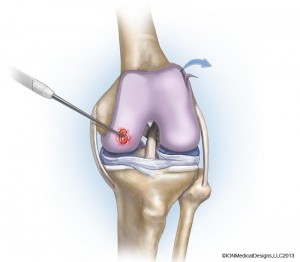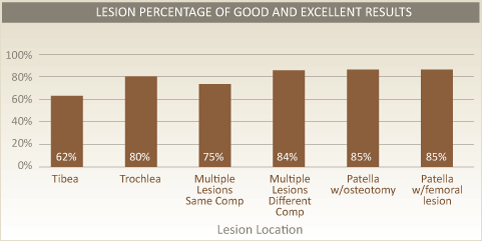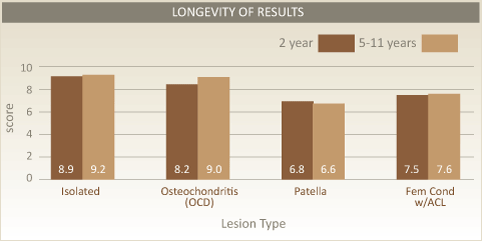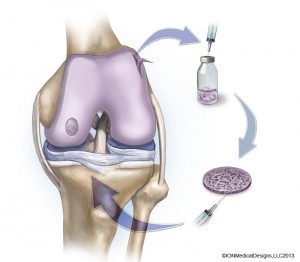ACI – Carticel
ACI (Autologous Chondrocyte Implantation) is a procedure that provides you and your doctor an option to repair articular cartilage injuries by implanting your own (“Autologous”) cultured cartilage cells (Chondrocytes) in damaged areas of your knee. These autologous cultured chondrocytes are called Carticel.
Carticel has demonstrated important benefits in patients with damaged articular cartilage. Carticel is indicated for the repair of symptomatic, cartilaginous defects of the joint surface, caused by acute or repetitive trauma, in patients who have had an inadequate response to a prior arthroscopic or other surgical repair procedure. Carticel is not indicated for the treatment of cartilage damage associated with osteoarthritis.
The unique advantage of ACI (Autologous Chondrocyte Implantation, or Carticel) is that we can now, for the first time, repair injury to the joint surface back to nearly the original Hyaline Cartilage. A few thousand cells are harvested from the non-weight bearing area of the joint. They are then grown under strict conditions and sterile procedures. Then, in a second operative procedure, a piece of the lining of the bone or another allograph biologic material is transposed to cover the defect. The cells are then implanted under this lid and into the closed space thus created. (See ACI procedure)
success rate
The results of the cell implant procedure can be impressive. In some cases, patients with chronic knee pain (as long as 20 years) became pain free after the implant operative procedure. In some patients a hole in the femoral condyle (thigh side of the knee joint) which would have almost assuredly lead to osteoarthritis, was treated leading to no symptoms. ACI may well save the patient as much as 20 to 25 years without significant problems.
Statistics show that for the isolated lesion, there is a 92% success rate, for multiple lesions within the same knee compartment there is an 85% success rate. For people with kneecap problems there is an 85-87% success rate if done with an osteotomy procedure. These are important numbers because here-to-fore, surgeons had no good options for these significant lesions. Beyond these impressive statistics, the cartilage grown and therefore the procedure has been shown to be very durable. Dr. Peterson found the results at two years equal the results at 11 years. That means that the results do not deteriorate with time and therefore these procedures can offer long-term benefits for selected patients.
Charts adapted from Peterson , et al.
Your results may vary, but ACI offers a chance to save further knee deterioration in selected cases. For improved results some cases require corrective bony realignments called osteotomies. That means in some patients, the tibia may need to be cut to realign forces on the knee joint or the patella attachment may need to be elevated to take pressure off the kneecap. Stability is also very important. If the anterior cruciate ligament has been torn, it needs to be reconstructed to stabilize the knee prior to or in concurrence with ACI. The result is that the implant operation can take from 2 hours for a simple singular lesion to as much as 4-6 hours for complicated lesions with a bony osteotomy.
after the procedure
After the operation, you will need extensive rehabilitation that is particular to your lesion or lesions and your operation. Often there will be some time of non-weight bearing and use of crutches. There will usually be some limited range of motion, ROM, as controlled by a hinged brace. Most surgeons use a CPM, continuous passive motion, machine to keep the knee limber without putting pressure across the joint. Slowly and progressively your ROM will be increased. Your strength will follow. Interestingly, many patients start to feel so good that they want to move to higher levels of activity too soon. Unfortunately, in some cases the surgeon has to hold the patient back. Regardless of how the patient feels, physiology just takes some time. The graft or implant will not mature to allow high compression forces until about 9 months. If the patient is too active too soon, the graft can seriously be compromised or fail. Therefore, most patients will not be able to run until about 9 to 12 months. However, you will be allowed to be full weight bearing at about 6-8 weeks of your surgery. Lastly the grafts cartilage regenerative process will be complete at about 18 months. It is at this time that the joint has been restored.
ACI, Carticel, has been shown to be a viable option for selected lesions. Though the implant procedure is inconvenient because of the time obligation involved, the results can be very gratifying.
the aci procedure
For articular cartilage defects greater than 1.5 cm in diameter, one of the more advanced techniques for cartilage restoration is Autologous Chondrocyte Implantation, or the Carticel procedure. This technique was originated in Sweden almost 20 years ago. It was FDA approved in the USA in 1995. The ACI procedure has been advanced in key cartilage centers such as The Joint Preservation Center. Surgeons in the JPC have been doing the procedure since 1998, lecturing nationally and internationally on the procedure, teaching the technique to interested surgeons and creating new adaptations and theories.
This unique procedure, a result of bio-technology, actually uses your own cartilage to restore defects in the joint surface. The first of the two stage procedure is performed with an arthroscope. The joint is thoroughly assessed and injury patterns are evaluated. In preparation for implantation, a small amount of your articular cartilage is harvested. It is sent to a special laboratory where, through advanced cell culturing techniques, the cell number is increased from a few hundred thousand to over 12 million cells. These cells are implanted into the knee joint through a second open operative procedure. The cells are injected under a lid created by a piece of your bone lining (periosteum) or a piece of commercial graph tissue (usually porcine or equine though others are being researched), which is sutured over the defect. The new cells adhere to the base of the defect within 6 hours and begin to grow. Complete healing takes several months but eventually, the joint is restored and returned to almost pre-injury status reestablishing the articular surface.
history of aci
ACI has been worldwide for over fifteen years. It was originally conceived and tested by Lars Peterson, MD in Sweden and it is through much of his data that we have found the impressive results of ACI. He found that chondrocytes, cartilage cells, could be grown in a special culture medium and rapidly increase their numbers.
He was able to control the cell growth so that they become Hyaline Cartilage. Hyaline Cartilage is very special. It covers the bone ends of all the joints. Joint surface cartilage, Hyaline Cartilage, does not repair itself; rather once damaged it can deteriorate through a complicated cascade of mechanical and chemical influences resulting in Degenerative Osteoarthritis.
For more information go to www.carticel.com



